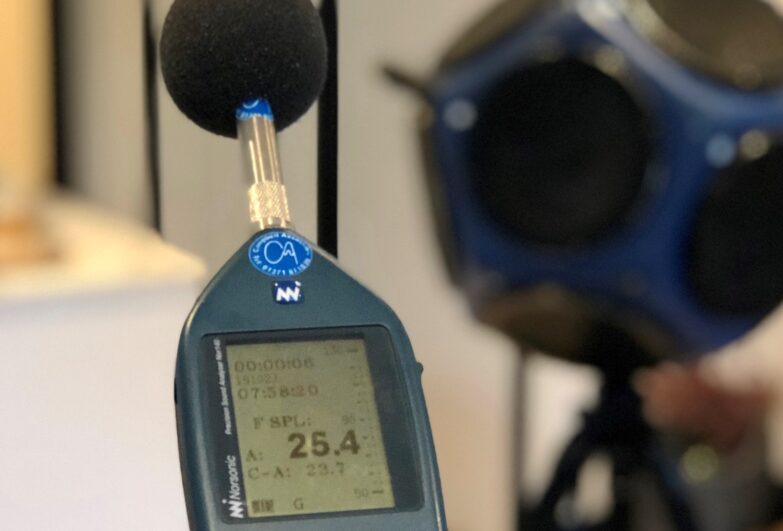Sound Testing Dwellings
Sound Testing Dwellings. APT Sound Testing has undertaken thousands of sound insulation tests on all types of dwellings that require […]

Sound Testing Dwellings.
APT Sound Testing has undertaken thousands of sound insulation tests on all types of dwellings that require sound testing such as pairs of semi-detached houses, right up to blocks of flat containing hundreds of units. This may be a new build as well as a conversion project.
There is lots of useful information within a section in Building Regulations called “Approved Document E” this document provides details for the resistance to the passage of sound and sound insulation for flats, houses, and rooms for residential use.
It can be hard to know how you need to prepare your development – to try and help our clients to prepare for their sound testing we have prepared our Sound Testing Checklist, which offers lots of advice on how best prepare your project for sound insulation testing.

How is sound testing undertaken?
The onsite sound testing procedure is quite simple, and our engineer will be happy to explain this on-site on the day of the test. For houses you only need to worry about airborne party wall tests; however, for flats and rooms for residential purposes, there are two types of sound insulation tests which are airborne and impact sound insulation tests for walls and floors.
The airborne sound insulation test is carried out by means of a high-powered loudspeaker, which emits a steady source of noise on one side of the partition (wall or floor). whilst the speaker is running, corresponding sound levels are measured on the other side of the wall and/or floor partition.
Impact sound insulation tests are carried out by means of a tapping machine, which has 5 mechanical hammers that fall onto the party floor to be measured, the corresponding sound levels are measured on the other side of the floor partition in the room or space below.
Acoustic calculations are done based on the above parameters using the gathered measurements, which is then compared to the Building Regulations Part E sound insulation requirements for type of the building.
How many dwellings need to be Sound Tested?
This is one of the most common questions we get asked. Approved Document-E states “Building control bodies should stipulate at least one set of sound tests for every ten dwelling houses, flats or rooms for residential purposes in a group or sub-group” – but this is more complex than it seems at first glance and is often wrongly interpreted as 10%. If the flats on the development have several different construction types, you may need more than the one set of tests in ten stated above.
For instance, a group can be determined by the type of dwelling, so houses, bungalows, flats are all different and should be treated separately for the number of tests, so if you have a pair of semi-detached houses and a block of 6 flats the development should require the following testing:
2 airborne wall tests to the semi-detached houses
2 airborne wall tests to the flats
2 airborne floor tests to the flats
2 impact floor tests to the flats
Subgroups can be quite complex, and we advise letting us look at each project individually to establish whether your project’s construction type means you’ll need additional testing. We are always happy to take a look at your project on an individual basis to help ensure you are booking the correct number of sound tests to ensure compliance with Approved Document E and achieve Building Control Signoff.
The required insulation performance for dwellings
According to building regulations Part E1, the minimum level of airborne and impact sound resistance for new build and conversion dwellings are:
• Airborne – 45dB for dividing walls or floors between homes for new build and 43dB in conversion projects
• Impact – a maximum transmittance level of 62dB for floors and stairs in new builds, and 64dB in conversion projects
What rooms need sound testing in dwellings?
Approved Document E also specifies which rooms need to be tested on each particular project. Sound testing is required between the ‘habitable’ living spaces, which usually includes:
Living room
Bedrooms
Study
Dining room
Kitchen
Wherever possible its usually best to test the Living Rooms and Bedrooms; however, if this is not possible then, Studies, Dining rooms and Kitchens can also be used. Although there is no requirement to test between common areas such as stairwells, corridors, and hallways, if no suitable rooms are available then building control may insist that a test is carried out between a stairwell and a bedroom and/or a bedroom and bathroom.
Preparing Dividing Floors for Sound Testing in dwellings
One of the keys to securing a sound test pass is ensuring that everything within the building is adequacy prepared for the testing. To help clients set up their projects for the sound testing, we’ve put together this comprehensive list detailing which parts of the property need to be prepared in advance for the airborne and impact sound testing:
1. The whole building envelope and internal walls and floors should be fully completed.
2. All windows and doors must be fitted and working correctly. A substantial amount of noise can leak through any gaps and can have a negative influence on the final test results.
3. All electrical fittings must be completely in-place, and fully functional. A poor electrical installation such as missing sockets/faceplates downlighters etc. can lead to excess noise.
4. No carpets or laminated flooring should be fitted on the 1st-floor levels or above. These materials can affect the movement of noise, and as a result, could impact whether a building passes the soundcheck test.
5. 240-volt power should be in place and available in every room. Our testing equipment can be damaged by the voltage fluctuations of on-site power generators, so it’s essential to have a 240V mains supply on-site on the day of the test.
6. The building skirting should not touch the floating floor and flanking strips used as and where required.
7. All gaps in the walls and floors should be sealed with acoustic mastic etc. Noise can leak out through any gaps and affect the movement of sound and impact on the sound insulation performance.
8. SVP pipe runs should be adequately boxed out and wrapped with acoustic insulation.
9. Access to all of the rooms on all levels should be granted to our technicians – also in occupied neighbouring properties where required. All site noise sources such as building work, radios, and fire alarms should be stopped for the duration of the test.
10. Neighbours should be prewarned about the access (we may need to have access into their dwelling) if their property is listed on the sound test schedule. Neighbours should also be warned about the loudspeaker noise prior to the test.
Preparing the building (and neighbours) in line with the above items are essential if we are to achieve accurate sound test readings. If any of them are ignored, there is an increased risk of you either failing your test or at worst, not being able to complete the testing.
If you would like more information on how to prepare for your sound testing please download our informative sound test checklist.
Our One-Stop Acoustic Design and Sound Test Service
Our acoustic engineers have carried out over 10,000 sound insulation tests and have the experience to help you on any scheme. Using our pre-completion testing service gives you:
• quick response, fast results – the sound testing is arranged around your build schedule, and you will receive an immediate indication of test performance on-site, with a full certificate/report sent electronically shortly afterward.
• expert remedial acoustic advice – if your project fails any of the sound tests, we try to help you achieve compliance as quickly as possible. We will whenever possible, undertake re-tests during the same visit to help you get the pass you need.
• complete compliance signoff solution – if you combine your sound insulation testing with our air leakage and energy assessment services. We will ensure swift communication between teams to clear outstanding technical conditions.
Need Advice about Sound Testing Dwellings
APT Sound Testing is UKAS accredited to undertake Sound Insulation Testing under ISO/IEC 17025:2017. As a UKAS accredited laboratory, we are required to attain the highest standards at all times.
If you require a ‘one stop’ acoustic service, then please contact us today. We can help with the acoustic design of your project, as well as the final precompletion sound testing.
Alternatively, if you would like more information in regard to sound testing please follow our blog or contact us at: info@aptsoundtesting.co.uk or 01525 303905.